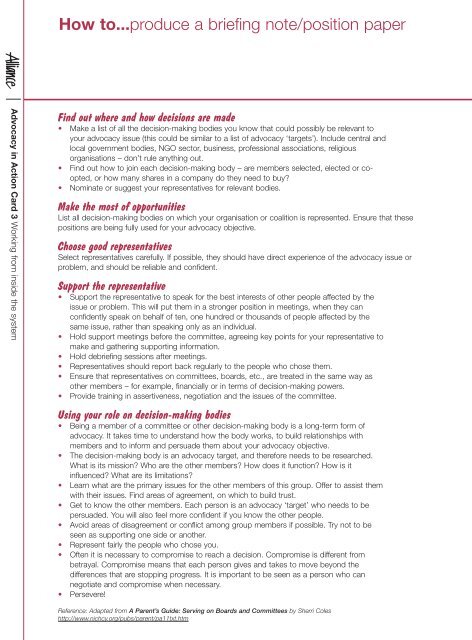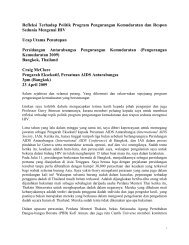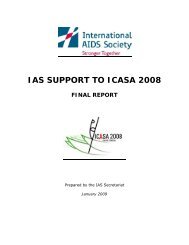Advocacy in Action - International AIDS Society
Advocacy in Action - International AIDS Society
Advocacy in Action - International AIDS Society
Create successful ePaper yourself
Turn your PDF publications into a flip-book with our unique Google optimized e-Paper software.
How to...produce a brief<strong>in</strong>g note/position paper<br />
<strong>Advocacy</strong> <strong>in</strong> <strong>Action</strong> Card 3 Work<strong>in</strong>g from <strong>in</strong>side the system<br />
F<strong>in</strong>d out where and how decisions are made<br />
• Make a list of all the decision-mak<strong>in</strong>g bodies you know that could possibly be relevant to<br />
your advocacy issue (this could be similar to a list of advocacy ‘targets’). Include central and<br />
local government bodies, NGO sector, bus<strong>in</strong>ess, professional associations, religious<br />
organisations – don’t rule anyth<strong>in</strong>g out.<br />
• F<strong>in</strong>d out how to jo<strong>in</strong> each decision-mak<strong>in</strong>g body – are members selected, elected or coopted,<br />
or how many shares <strong>in</strong> a company do they need to buy?<br />
• Nom<strong>in</strong>ate or suggest your representatives for relevant bodies.<br />
Make the most of opportunities<br />
List all decision-mak<strong>in</strong>g bodies on which your organisation or coalition is represented. Ensure that these<br />
positions are be<strong>in</strong>g fully used for your advocacy objective.<br />
Choose good representatives<br />
Select representatives carefully. If possible, they should have direct experience of the advocacy issue or<br />
problem, and should be reliable and confident.<br />
Support the representative<br />
• Support the representative to speak for the best <strong>in</strong>terests of other people affected by the<br />
issue or problem. This will put them <strong>in</strong> a stronger position <strong>in</strong> meet<strong>in</strong>gs, when they can<br />
confidently speak on behalf of ten, one hundred or thousands of people affected by the<br />
same issue, rather than speak<strong>in</strong>g only as an <strong>in</strong>dividual.<br />
• Hold support meet<strong>in</strong>gs before the committee, agree<strong>in</strong>g key po<strong>in</strong>ts for your representative to<br />
make and gather<strong>in</strong>g support<strong>in</strong>g <strong>in</strong>formation.<br />
• Hold debrief<strong>in</strong>g sessions after meet<strong>in</strong>gs.<br />
• Representatives should report back regularly to the people who chose them.<br />
• Ensure that representatives on committees, boards, etc., are treated <strong>in</strong> the same way as<br />
other members – for example, f<strong>in</strong>ancially or <strong>in</strong> terms of decision-mak<strong>in</strong>g powers.<br />
• Provide tra<strong>in</strong><strong>in</strong>g <strong>in</strong> assertiveness, negotiation and the issues of the committee.<br />
Us<strong>in</strong>g your role on decision-mak<strong>in</strong>g bodies<br />
• Be<strong>in</strong>g a member of a committee or other decision-mak<strong>in</strong>g body is a long-term form of<br />
advocacy. It takes time to understand how the body works, to build relationships with<br />
members and to <strong>in</strong>form and persuade them about your advocacy objective.<br />
• The decision-mak<strong>in</strong>g body is an advocacy target, and therefore needs to be researched.<br />
What is its mission? Who are the other members? How does it function? How is it<br />
<strong>in</strong>fluenced? What are its limitations?<br />
• Learn what are the primary issues for the other members of this group. Offer to assist them<br />
with their issues. F<strong>in</strong>d areas of agreement, on which to build trust.<br />
• Get to know the other members. Each person is an advocacy ‘target’ who needs to be<br />
persuaded. You will also feel more confident if you know the other people.<br />
• Avoid areas of disagreement or conflict among group members if possible. Try not to be<br />
seen as support<strong>in</strong>g one side or another.<br />
• Represent fairly the people who chose you.<br />
• Often it is necessary to compromise to reach a decision. Compromise is different from<br />
betrayal. Compromise means that each person gives and takes to move beyond the<br />
differences that are stopp<strong>in</strong>g progress. It is important to be seen as a person who can<br />
negotiate and compromise when necessary.<br />
• Persevere!<br />
Reference: Adapted from A Parent’s Guide: Serv<strong>in</strong>g on Boards and Committees by Sherri Coles<br />
http://www.nichcy.org/pubs/parent/pa11txt.htm
















